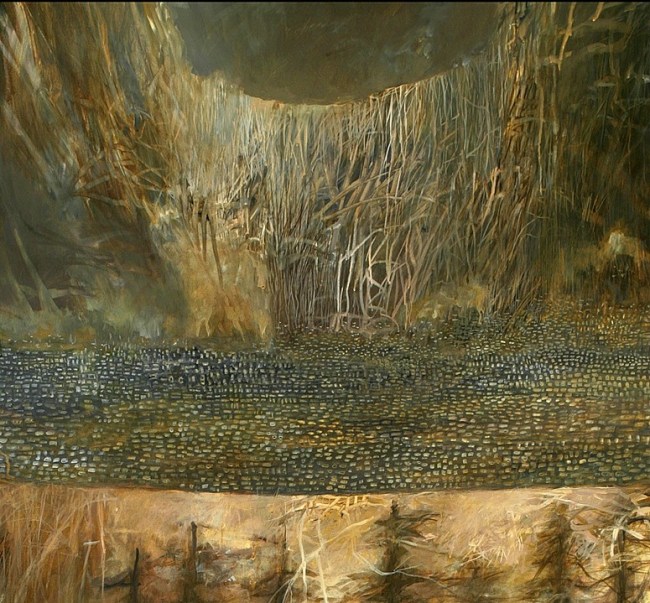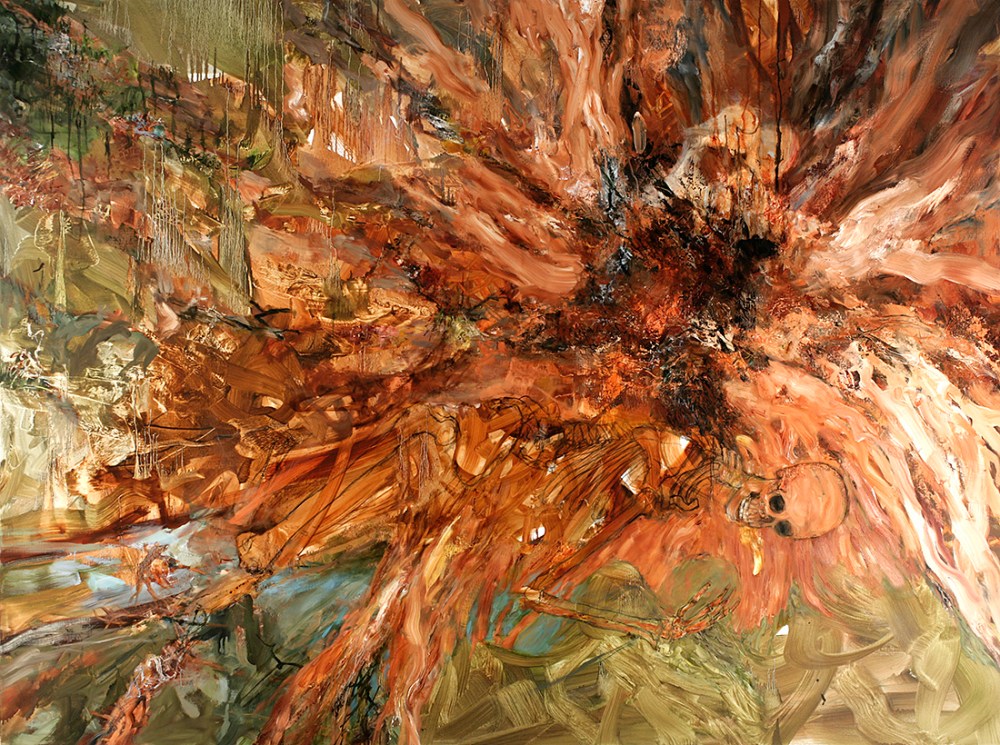By Etty Yaniv
Painter Joyce Yamada grew up on the West Coast. She spent her childhood vacations in the beautiful national parks of the US and Canada where pristine forests and the Pacific coast were imprinted in her visual memory. Although as a teenager she realized that art was what she wanted to do, struggling to survive on minimum wage led her to medical school, which she completed. She subsequently became a diagnostic radiologist.
This science background has fed her mind and artwork ever since. Yamada says she is a painter because she conceptualizes in images rather than in words: “When puzzled, my mind juxtaposes or fuses unexpected images, often leading to new work.†An early series, Body, Earth, came to her in art school. While she was looking at the hills across the bay from San Francisco, she saw the low rounded hills as the reclining body of a woman. The juxtaposed imagery meant to her that we are intimately and indivisibly part of earth and nature, that what we do to the earth we do to ourselves. She has subsequently seen this idea expressed in Indigenous cultures, and it became central in her work.

Let’s start with the impact of science on your artwork. What drew you there and how is science reflected in your process and imagery?
Science is a way of understanding how the physical world actually works. Its methods of review and verification appeal to me strongly. I also love the exploration of the natural world that science spearheads; I am inspired by imagery from space and from the deep oceans. My interest in ecology and the environment began in earnest in the early 1990s after pivotal trips to the temperate rainforests of Washington’s Olympic Peninsula. Flying over Oregon on the approach to Seattle, and then driving from there to the rainforests revealed how utterly rapaciously we are destroying our forests. From that experience came the first body of work, Truncated Landscapes, that felt deeply personal. The process that birthed that series is typical of how I work. I was struck by the geometric patterns of logging – huge rectangles of forest had been cut out of still intact forest growing on steep hillsides. The first painting in the series was Shado-nine forest, which closely mirrored the actual landscape. This evolved into cubical cut-outs of forests that were deracinated, literally cut off from their roots, floating in a human-induced wasteland and dripping blood while at it. This was from my Cassandra period of quiet environmental protest.

Images of trees are recurrent throughout your work. Let’s take a look at two images, one from 2003, Rainforest – Green Stream, and the more recent one from 2018, Green Burial. Can you tell me about the genesis of each? What were your ideas and how do the two images differ?
Green Stream came directly from a visit to the Hoh National Forest in Washington. A beautiful, complex stream meandered through old growth forest, the entire scene a beautiful green, the air clean and enlivening. This painting was a straightforward celebration of a specific place, though the details were entirely invented. After being inspired to read about temperate rainforest ecology, I also understood it as a demonstration of how old growth forests filter water through intact fallen tree branches, which also provide excellent nurseries for baby fish. Green Burial had a longer conceptual genesis that includes numerous recent drawings and paintings; it was inspired by a photograph of a huge tree in Ireland that toppled over, revealing a human skeleton embedded in its enormous roots. This felt mythological to me – an image of the human animal entwined in the roots and the very substance of the World Tree, a contemplation of the human in relation to nature. Recent related paintings include Yorick Root, Communicant, and Wood-wide Web.


Your paintings can be read as landscapes. How do you see them in the context of art history?
I made a decision during art school to stop conceptualizing my work in terms of art history because doing so was messing up my art-making process. This enabled me to stand outside of current trends without caring too much. I can’t therefore speak very knowledgeably about art history. I rarely paint actual locations. I often paint trees because they are the non-human, non-animal life form to which I relate most strongly. Trees and forests tend to be my shorthand for Nature. For many years, I also played with tree and human anatomy – trunks and limbs – to make our interconnections literal. I also use landscapes as evidence of human misuse, abuse, and ignorance of how to survive sustainably. Every place on Earth is a current or near-future ruin though if we act quickly enough, much can still recover. I have been contemplating the place of humans within nature, and therefore within the landscape.
Tell me about your series Hominidae.
Over the past 15 years, I have invented two different symbolic humans. The first was Waterhuman, a human made entirely of water, prone to evaporation and shimmering as it walks through the world; examples include Heaven’s Net and W.H with Furfish. My current version is Yorick, a living skeleton who will journey through natural scenes on Earth as well as through imaginary scenes in the wider cosmos. A symbolic human is a storytelling stratagem – a way of contemplating the human species in the wider world. Hominidae is the scientific nomenclature for the family that contains us humans – Homo sapiens. Using the term emphasizes our intimate connection with other creatures. Science reveals that we are a very young species evolved from related animals, not de novo Masters of the Universe. The family Hominidae includes the Great Apes and the various ancient hominids, of which only our species now survives. The other members of the family include orangutans, gorillas, chimpanzees, and bonobos.


We have been through a rough time period globally. How has your work been affected by the pandemic?
Early on I did several pandemic paintings – APRIL 2020 and Corona – by way of coping. Since then I have been painting favorite animals for solace. The pandemic’s associated social unrest, our weird violent weather, and melting polar icecaps indicate that human civilization and climate will be changing ever more cataclysmically on a global scale. I am inspired to forge ahead with new work while I still can.
What are you working on now?
I am curating an environmental group show for January 2022, as well as preparing a solo show in November 2022, both at the Amos Eno Gallery in New York City. I have been wanting to paint Yorick wandering about like a character in Douglas Adams’ Hitchhiker’s Guide to the Galaxy, mostly on Earth (which is truly wondrous and odd if you look closely at its creatures), but possibly also in outrageous outer space scenarios. It should be fun.

(All photo courtesy of the artist unless otherwise indicated.)
This interview is part of a content collaboration between Art Spiel and Artists & Climate Change. It was originally published on Art Spiel on December 21, 2020 as part of an ongoing interview series with contemporary artists.
______________________________
Etty Yaniv works on her art, art writing, and curatorial projects in Brooklyn. She has exhibited her immersive installations in museums and galleries, nationally and internationally. Yaniv founded the platform Art Spiel to highlight the work of contemporary artists through art reviews, studio visits, and interviews with artists, curators, and gallerists. Yaniv holds a BA in Psychology and English Literature from Tel Aviv University, a BFA from Parsons School of Design, and an MFA from SUNY Purchase.
———-
Artists and Climate Change is a blog that tracks artistic responses from all disciplines to the problem of climate change. It is both a study about what is being done, and a resource for anyone interested in the subject. Art has the power to reframe the conversation about our environmental crisis so it is inclusive, constructive, and conducive to action. Art can, and should, shape our values and behavior so we are better equipped to face the formidable challenge in front of us.
Go to the Artists and Climate Change Blog
Powered by WPeMatico


